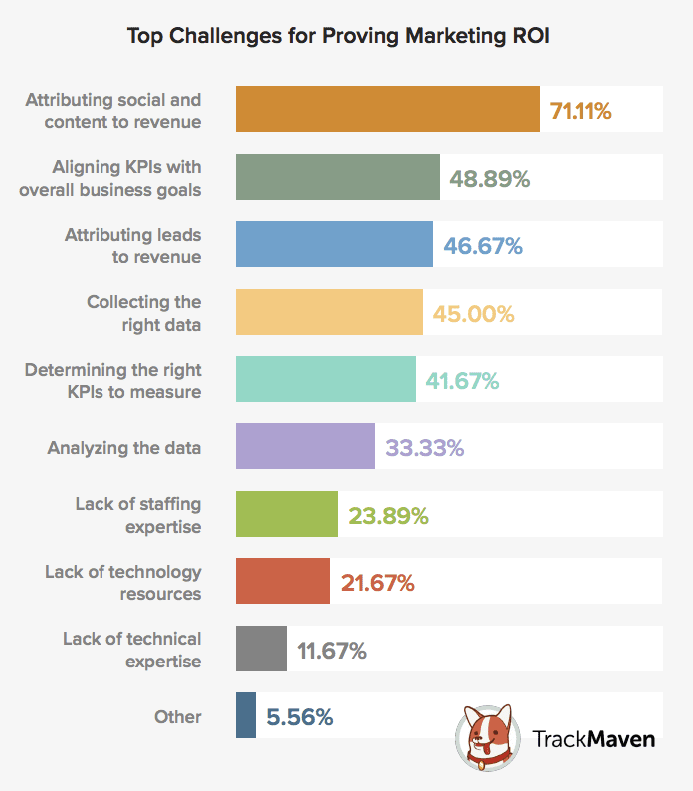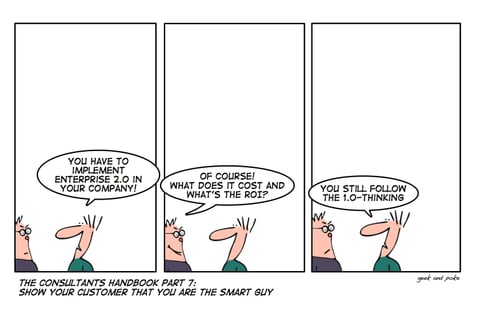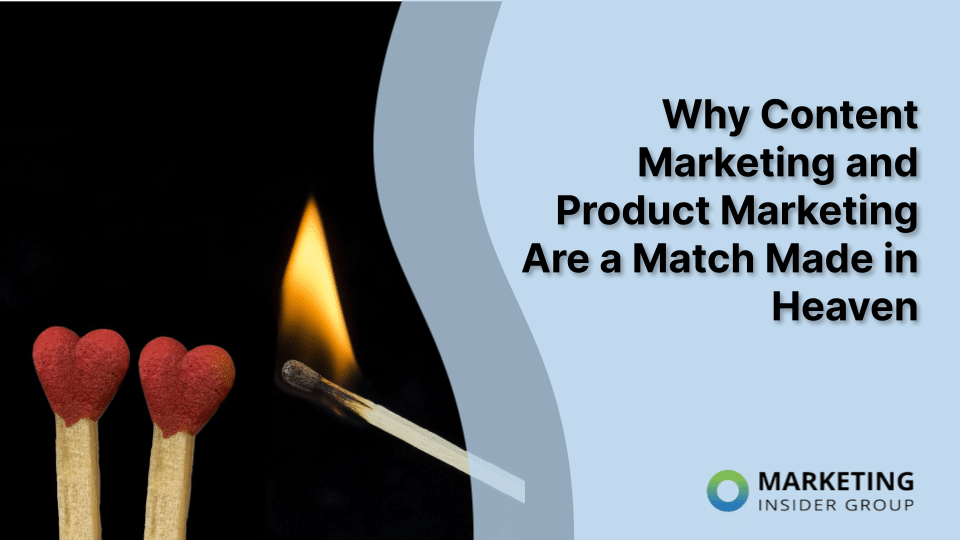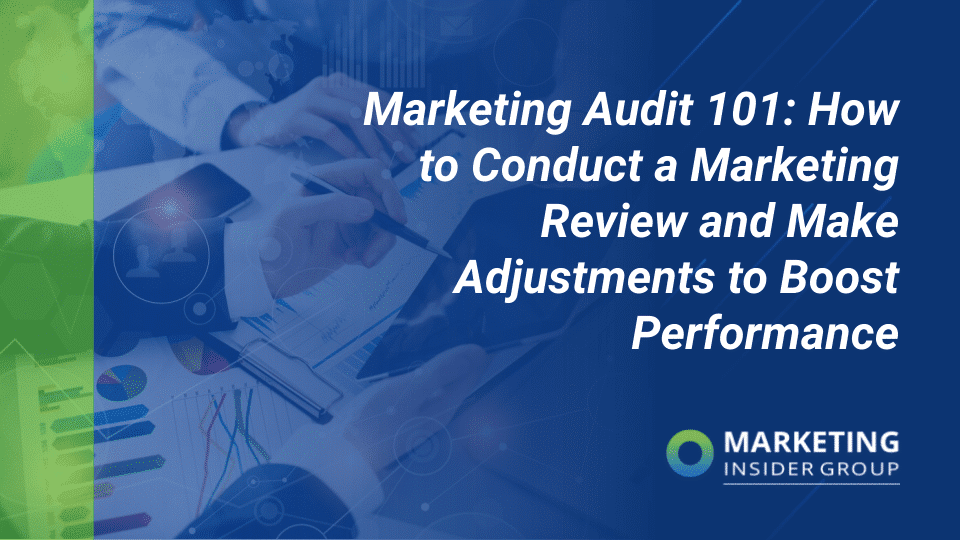
How to Solve the Challenge of Marketing ROI
For decades, marketers have hidden behind the tacit acceptance that “half of the marketing we do is effective, we just don’t know which half.”
While John Wanamaker was specifically referring to advertising all those years ago, we know this challenge applies to all the marketing channels we use in in today’s digital, social, and mobile-connected world.
A Demandbase study found that 71% of advertising campaigns fail to meet expectations. And 96% of digital marketers admitted that their advertising was a waste of money. Digital ads don’t work. And everyone knows it.
The pressure from CEOs and boards will only increase, as they demand to see marketing investments produce business results and a measurable return. Marketers need to highlight the value we bring to our organizations and present marketing as a strategic financial asset, with strategic business value that executives can understand in their own terms.
Solving the challenge of Marketing ROI does not have to be rocket science. The first step is simply in committing to measuring it. In this article we’ll cover the challenges, considerations, and approaches you can take right now to solve the marketing ROI challenge.
Marketing ROI Challenges
Since marketing is such a varied field, there are a gazillion obstacles that affect the smooth execution of every campaign. The most common challenges in proving ROI on your marketing include:

Calculating return on your marketing investment (ROMI) is something of an art form. Unlike capital investments, which have a fixed, upfront cost and clear results, marketing investments evolve over time and have both empirical and intangible results that are tricky to quantify. Many marketers struggle with measuring marketing ROI due to following reasons:
- Time: The process seems overwhelming when you consider all the channels, content, and agencies that support marketing efforts.
- Data and Tools: How will we collect the data and what tools do we need to get the job done?
- Skills: Analytics, Finance and Accounting are the not the strongest skill sets for many traditional marketers. The mad-men days are over as analytics is now a key skill for marketers to possess.
- Approach: What’s the best or easiest way to calculate ROI for your business?
All these may sound daunting – but creating a strong strategy for long-term growth and sticking to it will give you the best chance of an increase to your ROMI.
Your strategy and process can make or break your efforts. If executed well, you can get a good return on investment (ROI) for each and every marketing campaign you run.
Overcoming these challenges does not require an MBA in Finance, huge investments in technology, or a whole new team.
Difficulty in Quantifying Marketing ROI
According to a global survey conducted by programmatic marketing and analytics firm DataXu, this is the greatest challenge marketers currently face.
Over two-thirds of marketers surveyed say developing a deeper understanding of marketing technologies is critical to their marketing ROI and success. Further, 41% of global marketers and 37% of U.S. marketers said the biggest challenge facing their organizations is developing an efficient marketing mix across channels and platforms to deliver the best marketing ROI possible.
But a common roadblock they face in doing so is poor visibility into their metrics to identify what is working and isn’t, making it extremely difficult to measure the effectiveness of each channel. Some of the marketers surveyed attributed this challenge to the number of marketing technology platforms and vendors they need to manage. For many, they are working with ten or more platforms and vendors across the martech landscape, which makes it difficult for marketers to get a unified measurement.
The president and CEO of DataXu Mike Baker also thinks the measurement problem is caused by the “wall gardens” many companies have built around their channels. Digital platforms like Facebook and Google may be able to offer marketers better customer insights into how their marketing is performing within each wall garden, but the problem for marketers is that these platforms cannot measure one another.
Without a unified measurement across these different walled gardens, marketers do not have a way to effectively measure and compare their marketing investment and ROI.
Solving The Marketing ROI Challenge With “Simple ROI”
Can your business answer the question: “what’s the ROI of your Marketing?”
Warning! Math ahead: The answer is as simple as measuring revenue generated from marketing activities, less the investment you made to generate that revenue, and divided by the investment.

Now I am not a math expert. (In fact, I became an English Literature major in college after taking Finance and Accounting 101 courses.)
But even I can see that what’s interesting about this simple calculation, is that investment shows up twice. This means that for the majority of organizations, all you have to do is get more results from the same budget. Or get the same results with less budget.
This involves making trade-off calculations. And it means canceling programs that don’t produce a measurable return.
How are those banner ads working out for you? What about the sales brochures your team spend a ton of money creating?
If you can’t measure the return on marketing activities, simply stop investing in them. This is why content marketing is so effective. With a relatively low cost (compared to advertising) and a high measurability factor, showing the ROI of content marketing is just simple math.
Building the Business Case for Your Campaigns
Too often, budgets and marketing plans are simply based on last year (minus some standard percent). Or we look at all the people we have and determine who should have funds based loosely on the priorities those people represent. I have met and spoken to people from companies far and wide who have shared this experience! And this makes me want to scream: Whatever happened to the business case?

Building a business case is hard because it starts by questioning the conventional wisdom. It can mean challenging those above you. But if it is done right, this approach can mean better results and accolades for you and your management team. Higher risk = higher reward. I don’t even believe there are risks. Challenging conventional wisdom in a respectful way can lead to the kind of insights that most people miss. And that can bring huge rewards.
In the marketing strategy post I referenced above, I mention an old boss. He was the marketing leader of a former company. I actually followed him on my own career path as he rose through the ranks. He was respected in some cases and in other cases he was more feared. I just thought he was smart. And here’s why: if you wanted funding, you had to create a business plan. If you had a new idea and wanted to propose a change in strategy, you had to present a clear and concise business case.
What I am talking about is an actual document, not a series of slides. And the document had to include words in complete sentences and financial calculations and projections performed by a financial business partner in our company. Sales projections? These had to be validated by the sales folks. Operational dependencies? These had to be agreed to by the Ops folks with the expected costs and required resources identified.
That can all sound very intimidating. And here is what he used to say: I know it sounds like a pain. But it will force you to focus your ideas. And at the end of the process, you may find you don’t have a strong business case. Great! Move on. But if you do, then you’ve not only proven the potential, but also practiced how you’ll sell it to your organization.
So as you finalize your new marketing campaign for each channel, ask yourself if you have a solid business case. Are you solving the harder but more pressing issues faced by your company? Or are you surviving and going with the flow?
Step-By-Step ROMI Calculation That’s Right for Your Organization: An Example
So you’ve committed to measuring and presenting ROI for your marketing activities. How do you get started?
- Take a “simple ROI” approach for your entire team by identifying and including all “variable costs” such as media spend (advertising), and agency costs, as well as “fixed costs” such as salaries plus benefits and technology investments.
- Then use marketing-generated revenue to calculate overall Marketing ROI. Present this to the CEO and show him that Marketing has strategic value and is tied to the larger business objectives. Track and present overall Marketing ROI at each board meeting, and then optimize your marketing activities that produce the best return.
- Analyze campaign-level ROI. Here again, I recommend taking the simple approach. Measure the return of each program you run based on only the variable campaign investments of increased creative, content, media and agency expenses. And then approach every campaign with the same “simple” lens.
- The alternative is to apply a percentage of the fixed costs (salary, benefits, technology) to every campaign but this adds complexity that can be burdensome. For example, do you include corporate expenses? I think it’s important to understand that ROI measures are different from Financial statements and P&Ls which should include all fixed and variable costs. Still stuck?
- Partner with your finance and accounting colleagues. They can help with complicated formulas such as “hurdle rates,” NPV (Net Present Value), and IRR (Internal Rate of Return) when considering investments in various marketing activities. The variables they use should also be included in analyzing ROI after a campaign has run. Get their support and alignment as you present to the management team.
- Consider time-frames. Marketing results don’t happen overnight. And many campaigns from last year might continue generating results this year and next. My advice is to look at your average deal cycles. If it takes your customers 6 months to navigate their buyer journey to a purchase, then look at an even longer timeframe for Marketing ROI.
- Tools and technology can be used to help. CRM systems have become ubiquitous and mandatory technology for modern marketers. Make sure every campaign has a tracking code, measures some results that can be quantified (leads if not revenue). And if you can, ask your team to include variable budgets in your CRM system.
- Some research suggests that the average buyer touches 10-20 pieces of content before making a purchase decision. “Multi-Touch Attribution” can help assign value across multiple campaigns. This may require some special tools and skills, but some common approaches are “first-touch” (assigning all value to the first campaign that touches a buyer), “last touch,” or “weighted” where some level of attribution is applied across all marketing campaigns that touch the buyer.
Marketing ROI: Tips, Tricks and Best Practices
Here are some useful strategies that can help you turn efforts into results and ensure a positive return on your marketing investments:
Define your ROI Measures
Following the formulas to calculate your ROMI is the first step to understanding what works and what doesn’t. To improve lead generation you must know where your marketing efforts are bringing in money and where they aren’t.
While important, measuring your return on investment isn’t just about the formulas and the tangible return – it’s also about the intangible benefits too. Like presenting yourself as a thought leader or improving long-term online growth.
Defining the ROI measures of your content marketing will grant you insight on the intangibles like public perception and long-term online growth.
2. Publish Keyword-Driven Content
Keyword research is one of the best ways to increase your overall site traffic — not just in volume, but in quality. Having informed SEO practices will get more customers’ eyes on your site.
If you publish content optimized for high volume, low-difficulty phrases, you’re more likely to rank on page one of the SERPs, which of course means more visitors finding their way to your site.
You can go a step further by making sure this content (whether a blog post, a whitepaper, or a landing page) targets prospects that are closer to making a purchase, i.e. further “down the funnel.”
By doing this, you’re marketing to the prospects that are the easiest to access and the most likely to convert into customers!
Practice Social Marketing
If you aren’t leveraging social media as one of your primary marketing channels, you’re missing out on a lot of influence and opportunity, not to mention valuable insights about brand sentiment, advocacy, and the quality of client relationships.
HubSpot defines social marketing as “the process of creating content for social media platforms to promote your products and/or services, build community with your target audience, and drive traffic to your business.”
Many businesses now use social media as a direct source of leads. Those leads are qualified by their interests, firmographic info, and communication history, so they have a high chance of converting – even more than traditional outbound marketing (telemarketing, print, batch list emails, tv/radio)!
Need a refresher on social media’s place in your digital marketing plan? No problem – we’ve got you! For more info, check out 10 Digital Marketing Tips and Tricks from Top Brands.
Use A/B Testing
Regardless of what medium you’re working in, some tactics work better than others. A/B testing (sometimes referred to as “split testing”) is the process of comparing alternate versions of a similar asset and deciding which yields better results, without guesswork.
Marketers can run A/B tests on everything from web layouts to titles, subject lines, blog posts, and emails. While simple, incremental gains on positive yields add up big for your return on marketing investment.

Blow Away the Competition
Know thy enemy! Although this tactic is admittedly more reactive than others, it will help you siphon traffic back onto your site and into your lead revenue generation programs.
Do research on your competitors (these are the companies clients choose instead of yours, which often means they have the same target audience). How are they managing their image on social media? What types of paid advertising are they pursuing? How is their website UI?
Find out what your competitors are doing with their marketing strategies and do it better. You get the idea.
Invest in the Right Technology
There are thousands of software solutions for marketers, like email marketing, social analytics, web tracking, and content management. If you’re looking to bring all of these functions together into one system, you’re probably looking for marketing automation software.
The best marketing automation software for B2B companies is usually built around the lead generation process, designed to help you run programs across multiple channels, create custom rules and triggers, and ship more qualified leads to your sales department.
A marketing automation platform can also provide insights about campaign effectiveness through diagnostic tools and reporting (closed-loop reporting, visitor tracking, surveys, and content engagement metrics). Having this constant awareness of where your programs are succeeding and failing lets you make incremental corrections and reassess your overall strategy efficiently.
Use the Right Tools and Approaches
A good handyman knows which tool to use for the right job – and a good marketing specialist knows which medium to use to maximize their return on marketing investment.

This chart from PPC shows what surveyed companies view as their ROMI money makers. SEO ranked highest, with 28% of those asked saying that SEO gave them the best ROMI.
It’s not a shock that 80% of marketers have trouble proving the business value of their spending, campaigns, and activities. After all, solving the challenge of marketing ROI has been difficult since it was first popularized!
Even if you haven’t locked down a formula for ROMI, your investment decisions should still hinge on their ability to yield positive results. To be clear, we’re talking about investments either in traditional marketing programs (paid media, email nurturing, inbound) or in newer marketing technology, such as a marketing automation platform.
Ask yourself what value an investment could add to your brand, and whether that value would be direct profit (leads, conversions) or qualitative profit.
If you follow the logic, you’ll likely encounter these two fundamental questions:
- What kind of marketing investments are more likely to pay off?
- If my marketing investments are already failing, what adjustments can turn them around?
Marketing Investments With Compounding Rates of Return
The best way to demonstrate marketing ROI: Stick to programs you can measure. What’s the ROI of logos on a famous golfer’s hat? I have no idea.
Digital Content Marketing programs are financial assets with real value that you can prove!
Content marketing is about acting like a publisher and sharing your expertise on a digital property you own.
If you track the sales and leads from these platforms, you will see a compounding rate of return from marketing, much like your 401K retirement account. See this example:

ROI is not a perfect science for marketing. The biggest challenge is committing to measure it in the first place. Then use it in making budget and investment decisions.
Because the “investment” part of the equation is so important, just stopping the marketing activities that don’t provide a measurable return is often the easiest way to improve your Marketing ROI. Then invest that “found” money into content marketing and other digital programs you can measure and optimize.
Give it Some Elbow Grease
It isn’t always enough to just dump more money or time into your current projects, especially if they aren’t performing well. That’s like flooring the accelerator when your car is stuck in the mud!
It also falsely simplifies prospect behavior: people don’t just want to be engaged for the sake of it; they want to be engaged in relevant, timely, personalized ways. They don’t want to follow the account that just republishes information every day, they want to follow the one that sounds like a person and interacts directly with them.
Having a more hands-on approach with your content media can provide your clients with more personal interactions, building rapport and brand loyalty. Who doesn’t love getting noticed by their favorite brand?
If you’re lucky, a prospect will convert after several, meaningful encounters with your brand across multiple channels (email, social, SERP, mobile). But marketers are eager to “hack” the process to gain a quick edge – time is money, after all. They want to know the shortcuts for turning prospects into leads, and leads into contracts, and that’s not necessarily a bad instinct.
Really, it’s about capitalizing on investments.

Are you interested in engaging and converting new customers for your business using the most important digital marketing trend: consistent and quality content? Check out our weekly blog content service or schedule a free consultation. Get started today and generate more traffic and leads for your business.







Hi Michael.
Great article on a subject that certainly worries all of us. Anyway, all this is fantastic when business is conducted digitally; my concern is how to calculate ROI when businesse is not conducted in the digital world. Because there’re still many companies who don’t do online business (sales) and who have no direct transactional contact with customers. Their business is conducted via retailers and, thus, is very difficult to correlate marketing activities and sales. They cannot even track (easily) how a customer navigated down the purchasing funnel until he/she took the product from the shelve.
I’m afraid that in this world not everything is digital; many business are still conducted in the real (physical) world where tracking codes cannot be applied, where many of the marketing activities happen in the store (eg. POS material), in traditional media, in professional magazines directed to retailers, etc. and where the control of the sale and contact with the customer doing the purchase is in the hands of the retailer. Just think of any major appliance manufacturer (Bosch, Miele, Elektrolux, Whirpool,…).None of the sell online. How do you calculate the ROI of marketing activities (effectively and economically) when most of them happen not in the click world but in the mortar one?
Many thanks for your thoughts.
Mr. Edorta Mendieta
Thanks Edorta, you raise a very good and important question. I think the approach I take is more customer-centric. So while you are correct, many transactions of products happen offline. Or some companies, like wholesalers, do not have visibility into their revenue streams. However, every one of those transactions has a person behind it. And EVERY person on the planet who buys stuff in this global digital world, uses online channels to search, discover, share, and engage with content surrounding or related to their transactions.
ROI may need to be discovered through share of voice, awareness, preference, or even simply company website traffic. The question every business should ask, no matter how digital their supply chain is, or no matter how much visibility they have to the sale, is how much share of the conversation do they have relative to other players in the supply chain.
For example, look at GE and all the content they create on their own and social platforms. While they might be selling items through intermediaries in some cases, they still want their buyers to come to their website and to experience their expertise ONLINE. That is valuable and measurable. Even if it doesn’t lead to direct sales.
Another way to look at it is this. How much activity with non-digital transactions CAN you measure the ROI. What is the ROI of a full-page ad in a magazine? Or the logo on a truck? For many companies, traditional methods like these are not conducted because of the ROI. But because a publisher sales rep has convinced a CEO that this is the only way to reach the target audience. But they offer no proof. But if that same company showed up first on a web search for the types of questions those customers ask their search engines. Or if that company produced online marketing that generates interest,, then there is ROI that can be measured relative to other marketing investment decisions.
My bottom line is this, no matter how you look at it, in every industry, there are people involved. Our society goes online to discover the majority of content we need to stay informed. The company that shows up for their buyers when we all go online, is the company that wins. And this customer-centric view can lead to calculations of value.
I hope this helps to answer the question and thanks for your interest in this topic.
Great job, Michael.
ROI is a challenge to be sure. But you’ve done a great job here showing how to calculate it in the simple way and the more complex way. I also like the fact that you encourage people to consider timeframes and that marketing doesn’t happen overnight.
As a side note, I use the same technique when writing about ROI — explaining the simple approach and then the more complex approach — in An Audience of One, which will be published by McGraw-Hill in September. (Yes, that’s a shameless plug, but it’s also a way to thank you for your early review quote which you’ll find on the back cover. Thanks!)
Glad to see you’re covering this topic. And I always assumed you were a math major given your work at Nielsen!
Cheers, Jamie